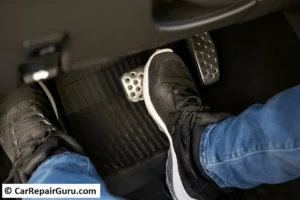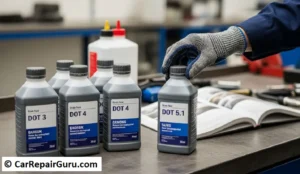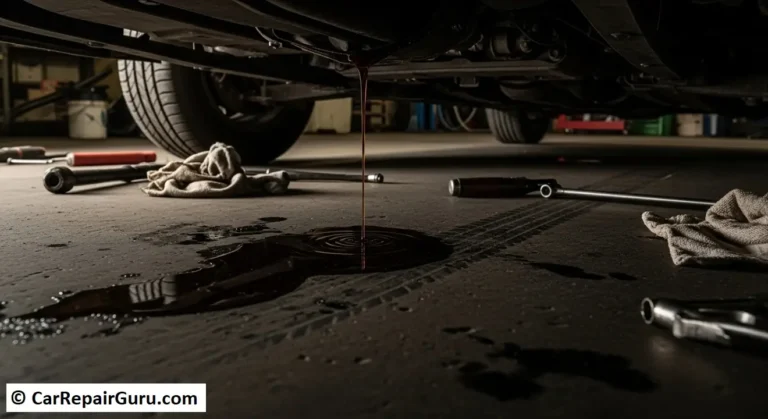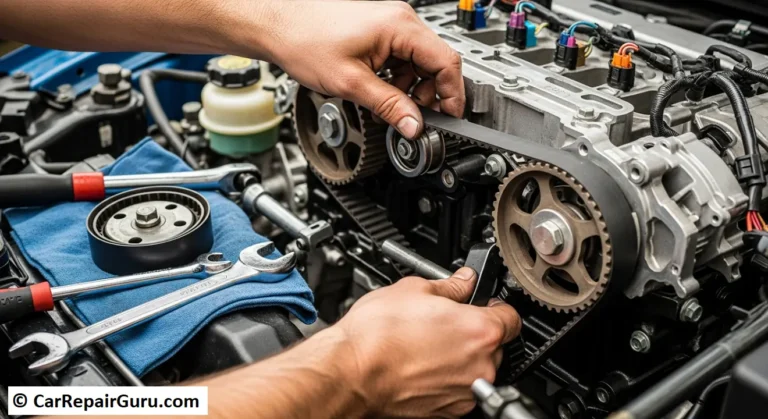
Ever hit the brakes and noticed they feel a little soft or unresponsive? That could be your vehicle’s way of telling you it’s time for some much-needed attention—specifically, a brake system flush. While it’s easy to stay on top of oil changes and tire rotations, brake fluid maintenance often flies under the radar, even though it’s just as essential for your safety.
So, what exactly is a brake system flush?
In simple terms, it’s the process of removing old, dirty brake fluid from your car’s braking system and replacing it with fresh fluid. Over time, brake fluid absorbs moisture, becomes contaminated, and loses its effectiveness. A flush clears out the gunk, air bubbles, and corrosion-causing moisture, restoring your brake system’s performance to its best.
Think of it like a detox for your car’s brakes. Clean, fresh fluid ensures your brakes respond quickly when you need them most—especially during sudden stops or wet road conditions. Skipping this critical service could mean longer stopping distances, potential damage to brake components, or even total brake failure.
That’s why a regular brake system flush isn’t just maintenance—it’s a crucial step toward keeping you and your passengers safe on the road.
What Is a Brake System Flush?
Let’s break it down simply:
A brake system flush is a maintenance procedure where all the old, dirty brake fluid is completely removed from your vehicle’s brake lines, and fresh, clean fluid is added in its place. It’s like giving your braking system a deep clean from the inside out.
You might be thinking, “Isn’t that just a brake fluid change?” Not quite.
Here’s the difference:
- A brake fluid change usually involves draining some of the old fluid and topping it off with new fluid. It’s quicker, but not as thorough.
- A brake fluid flush, on the other hand, replaces all the fluid in the brake system, including what’s trapped in the brake lines, calipers, and master cylinder. This ensures no contaminated or moisture-laden fluid remains.
So why does this matter?
Over time, brake fluid absorbs moisture from the air—a natural process called hygroscopic absorption. As moisture builds up, it reduces the fluid’s boiling point and leads to rust, corrosion, and poor brake performance. In short, your brakes may not work as effectively, especially in emergency situations.
A proper brake system flush helps prevent these issues, keeping your brakes sharp, responsive, and safe. It’s not just about maintenance—it’s about protecting your car and everyone inside it.
Why Is a Brake System Flush Important?
When it comes to car safety, your brakes are your first line of defense. But even the best braking system can’t do its job if the brake fluid inside it is old, contaminated, or moisture-ridden. That’s why a regular brake system flush is so important—it’s one of the easiest and most affordable ways to keep your car stopping safely and smoothly.
Brake System Reliability Starts with Clean Fluid
Imagine pressing your brake pedal and feeling a delayed or mushy response. That’s often a sign of degraded brake fluid. Flushing the system keeps everything running as it should—giving you consistent, confident braking performance in all driving conditions.
Prevents Brake Failure and Corrosion
Over time, brake fluid absorbs water from the air, which leads to rust inside critical components like the master cylinder, calipers, and brake lines. This internal corrosion doesn’t just reduce performance—it can cause expensive damage or, worse, complete brake failure. A brake system flush removes that moisture before it does harm, protecting the parts you can’t see but definitely rely on.
Protects ABS and Traction Control Systems
Modern vehicles rely heavily on advanced systems like ABS (Anti-lock Braking System) and traction control to keep you safe. These systems depend on clean, responsive brake fluid to work correctly. Dirty or old fluid can disrupt pressure sensors, leading to performance issues or warning lights on your dash. Keeping your fluid fresh ensures these safety features do what they’re built to do—keep you in control.
In short, a regular brake fluid flush isn’t just a smart maintenance choice—it’s a vital step in preventing breakdowns, protecting your vehicle, and ensuring your safety every time you drive.
Signs You Need a Brake Fluid Flush

Your car has a way of letting you know when something’s not right—especially when it comes to the braking system. If you’re noticing strange behavior when you hit the brakes, it could be your car’s way of saying: “Hey, I need a brake fluid flush!” Ignoring these signs could lead to more serious (and costly) problems down the road.
Here are some of the most common signs you need a brake fluid flush:
1. Spongy or Soft Brake Pedal
If your brake pedal feels soft, squishy, or goes down farther than usual before the brakes engage, that’s a major red flag. It often means there’s air or moisture in the brake lines, reducing the effectiveness of the brake fluid. A brake fluid flush can restore proper pedal feel and braking performance.
2. ABS Warning Light Is On
When the ABS warning light comes on, it’s often tied to issues with brake fluid pressure or contaminated fluid interfering with sensor readings. If your dashboard lights up, don’t ignore it—get your brake system inspected and flushed if necessary.
3. Dark or Dirty Brake Fluid
Take a quick look at your brake fluid reservoir (usually located on top of the master cylinder). Fresh fluid should be clear to light yellow. If it looks dark brown or dirty, it’s time for a change. Contaminated fluid can damage internal components and reduce braking power.
4. Longer Stopping Distances
Are you pressing harder than usual to come to a full stop? If your vehicle is taking longer to stop, your brake fluid may be losing its effectiveness, especially if it’s absorbed moisture. This is more than inconvenient—it’s dangerous.
5. Burning Smell During Hard Braking
A burning smell after heavy braking—like driving downhill or towing—could be a sign that your brake fluid is overheating. When this happens, your braking system can’t handle the heat, leading to brake fade or even system failure. A flush can help restore proper thermal performance.
Pro Tip: Don’t wait for your brakes to fail before acting. If you notice one or more of these symptoms, a brake fluid flush might be just what your car needs to stay safe and responsive.
How Often Should You Get a Brake System Flush?
Unlike oil changes or tire rotations, there’s no single answer for how often you should flush your brake fluid—it can vary depending on your car, how you drive, and where you live. But one thing’s for sure: ignoring brake fluid service for too long can lead to costly and dangerous consequences.
General Rule of Thumb
Most automakers recommend a brake system flush every 2 years or 30,000 miles, whichever comes first. However, it’s always best to check your vehicle’s owner’s manual for specific guidance tailored to your make and model.
Driving Habits Matter
If you regularly drive in stop-and-go traffic, tow heavy loads, or use your vehicle in high-performance conditions, your brake fluid wears out faster. These driving habits generate more heat in the braking system, which accelerates fluid breakdown and increases the risk of moisture contamination.
Climate Plays a Role Too
Live in a humid or rainy area? Your brake fluid is more likely to absorb moisture from the air, shortening its lifespan. On the flip side, if you’re in a dry or cooler climate, your fluid may last a bit longer—but it’s still smart to follow a regular maintenance schedule.
Not Sure? Get It Tested
If you can’t remember the last time your brake system was flushed, a mechanic can test the fluid with a moisture or boiling point tester. If it fails the test, it’s time for a fresh flush.
Bottom line: Even if your brakes feel fine, don’t skip your brake fluid service. Staying ahead of schedule can help you avoid surprise repairs—and ensure your vehicle stops exactly when and how you need it to.
How Is a Brake System Flush Performed?
So, how exactly does a brake system flush work? Whether you’re curious about what your mechanic is doing or thinking about tackling it yourself, here’s a step-by-step breakdown of the process. Flushing the brakes isn’t just about swapping out fluid—it’s about doing it right to ensure maximum safety and performance.
Step-by-Step Brake Fluid Flush Process
1. Lifting the Car Safely
First, the vehicle is securely lifted using a jack and jack stands (or a lift if you’re at a shop). This gives easy access to the bleeder screws on all four wheels.
2. Locating the Bleeder Screws
Each brake caliper has a bleeder valve or screw—this is where old fluid and trapped air are pushed out. These are typically found near the top of each caliper.
3. Flushing Fluid from Each Brake Line
The flushing starts at the wheel farthest from the master cylinder (usually the rear passenger side) and moves closer (rear driver, front passenger, front driver). Using a vacuum bleeder or manual pump, the old brake fluid is forced out until only clean fluid appears.
4. Refilling with New Brake Fluid (DOT 3, DOT 4, or DOT 5.1)
Fresh fluid is added to the master cylinder reservoir throughout the process to avoid introducing air. The type of fluid used—DOT 3, DOT 4, or DOT 5.1—depends on your vehicle’s requirements. Using the wrong type can damage your system, so always check your owner’s manual or consult a professional.
5. Bleeding Air from the System
Once all lines have been flushed, each brake line is carefully bled to remove any trapped air. Air bubbles can lead to a spongy brake pedal and decreased performance, so this step is critical.
DIY vs. Professional Brake Service: Which Is Better?
If you’re handy with tools, a DIY brake flush is doable—but only if you know what you’re doing. It requires the right equipment, clean technique, and strict attention to fluid types and brake line order.
However, if you’re unsure or don’t have the right tools, getting a professional brake fluid flush is worth the peace of mind. Mechanics use pressure or vacuum bleeding systems that ensure the job is done thoroughly and cleanly. Plus, they can spot other brake system issues while they’re at it.
Pro Tip: No matter who does it, what matters most is that it’s done right—and at regular intervals. A clean, air-free brake system means safer stops, longer component life, and total confidence on the road.
Brake Fluid Types and What You Should Use

Brake fluid might seem like a small detail, but using the right type is critical for your safety and your vehicle’s performance. There’s no one-size-fits-all fluid—each car is designed to work with a specific type, and getting it wrong can lead to reduced braking power or serious damage to the braking system.
Let’s take a look at the most common types: DOT 3, DOT 4, and DOT 5.1.
DOT 3 Brake Fluid
- Boiling Point: Lower than DOT 4 and DOT 5.1.
- Usage: Common in older vehicles and lighter-duty cars.
- Compatibility: Works in vehicles designed for DOT 3 only.
- Key Point: Absorbs moisture over time, which lowers its performance.
DOT 4 Brake Fluid
- Boiling Point: Higher than DOT 3, better suited for more demanding conditions.
- Usage: Found in most modern cars, especially with ABS or traction control systems.
- Compatibility: Can be used in place of DOT 3, but not vice versa.
- Key Point: Offers better heat resistance, especially during heavy braking.
DOT 5.1 Brake Fluid
- Boiling Point: Highest among the three; excellent for high-performance or heavy-duty use.
- Usage: Common in performance cars, tow vehicles, or cars that operate in extreme conditions.
- Compatibility: Can replace DOT 3 or DOT 4 (if system is compatible), but not interchangeable with DOT 5 (silicone-based).
- Key Point: Performs well under pressure but absorbs moisture just like DOT 3 and 4—so still needs regular flushing.
Why Choosing the Right Fluid Matters
Brake fluid isn’t just a liquid—it’s the lifeline of your braking system. Using the wrong type can:
- Cause seals to wear out or swell
- Reduce braking effectiveness
- Trigger ABS or traction control malfunctions
- Even void your warranty
Always check your owner’s manual to find the correct fluid type for your vehicle. If in doubt, consult a trusted mechanic before topping off or flushing your brake system.
Bottom line: When it comes to brake fluid types, don’t guess. Use the fluid your vehicle is designed for, and you’ll keep your brakes (and your peace of mind) in top shape.
Cost of a Brake Fluid Flush
Wondering how much a brake fluid flush costs—and whether it’s worth the money? The good news is that this vital service is one of the more affordable items on your car maintenance checklist. Let’s break down the cost, compare DIY vs. professional service, and look at what you risk by skipping it altogether.
Average Cost at a Shop or Dealership
At most auto repair shops or dealerships, a brake fluid flush typically costs between $80 and $150. This includes labor, proper disposal of old fluid, and a refill with the correct brake fluid (DOT 3, DOT 4, or DOT 5.1). The price can vary depending on:
- Your vehicle’s make and model
- Local labor rates
- Whether you choose a dealership or independent shop
DIY vs. Professional Brake Service
Thinking of doing it yourself? A DIY brake fluid flush can cost as little as $10–$30 for the fluid and about $20–$50 for tools like a bleeder kit. However, DIY isn’t for everyone. You’ll need:
- A jack and jack stands
- Proper tools and a bleeder kit
- Brake fluid that matches your vehicle’s specifications
- Patience and attention to detail (air in the lines = big problems)
DIY can save money, but if done incorrectly, it could lead to poor braking performance, ABS issues, or even system failure—which will cost a lot more in the long run.
Value vs. Risk: Why This Service Matters
It might be tempting to skip a flush, especially if your brakes feel fine. But over time, moisture builds up in the brake fluid, leading to:
- Corrosion of internal brake components
- Spongy brake pedal response
- Failure of safety systems like ABS and traction control
- Costly repairs or even accidents
Compared to the risk of brake failure or expensive part replacements, a $100 flush is a smart investment.
Bottom line: Whether you go DIY or hire a pro, a regular brake fluid flush is a low-cost service that delivers high-value safety and performance. Skipping it might save a little today, but it could cost you big tomorrow.
Risks of Skipping a Brake System Flush

Skipping a brake system flush might not seem like a big deal—especially if your brakes still feel okay. But just because your vehicle stops now doesn’t mean it’s stopping as safely or efficiently as it should. Over time, ignoring this simple service can lead to some serious consequences for both your car and your wallet.
1. Corrosion and Internal Damage
Brake fluid is hygroscopic, which means it naturally absorbs moisture from the air. That moisture leads to rust and corrosion inside critical components like:
- Brake calipers and wheel cylinders
- Brake lines
- ABS modules
Once corrosion sets in, you’re looking at expensive part replacements or even full brake system overhauls.
2. Reduced Braking Efficiency
Old, contaminated fluid loses its ability to handle heat. This results in:
- Spongy brake pedals
- Longer stopping distances
- Increased risk of brake fade during hard or repeated braking
In an emergency situation, that extra second it takes to stop can be the difference between a close call and a collision.
3. ABS Malfunction and Expensive Repairs
Your Anti-lock Braking System (ABS) relies heavily on clean, pressurized brake fluid. When that fluid becomes dirty or moisture-laden, it can cause sensors or valves to stick or fail.
And here’s the kicker: ABS repairs can cost $800 to $1,500 or more—far more than a simple $100 brake fluid flush would have cost.
Bottom line: Ignoring a brake system flush doesn’t just affect how your brakes feel—it can damage critical components, reduce your safety, and lead to high repair bills. Think of it as small, routine care that protects one of your car’s most important systems.
DIY vs. Professional Brake System Flush
If you’re comfortable with a wrench and don’t mind getting your hands dirty, you might be wondering: Can I do a brake system flush myself? The short answer is yes—but it’s not for everyone. Let’s weigh the pros and cons of DIY versus hiring a professional, and go over some essential safety tips for anyone considering a do-it-yourself approach.
DIY Brake System Flush: Pros & Cons
✅ Pros
- Cost savings: A DIY flush can cost as little as $20–$50 in materials.
- Learning experience: Great for gearheads and car enthusiasts.
- Convenience: Work on your schedule—no shop appointments needed.
❌ Cons
- Skill required: You’ll need to understand how to safely lift your car, locate bleeder valves, and correctly flush and bleed the system.
- Special tools: You’ll need tools like a brake bleeder kit, line wrenches, and a jack with stands. Messy work if you’re not prepared.
- Risk factor: A mistake (like letting air into the lines or using the wrong brake fluid) can seriously affect your braking performance—and safety.
When It’s Better to Hire a Professional
While the DIY route can be satisfying, it’s often safer to leave this job to a qualified mechanic, especially if:
- You don’t have the tools or workspace.
- Your vehicle has complex systems (like ABS or electronic stability control).
- You’ve never bled brake lines before.
- You’re unsure which brake fluid type your car needs (DOT 3, DOT 4, or DOT 5.1).
A professional brake fluid flush typically costs around $80–$150 and ensures the job is done correctly with no risk of air leaks, cross-contamination, or part damage.
Safety Tips for DIY Brake Flushes
If you’re confident and want to do it yourself, keep these safety tips in mind:
- Use the correct brake fluid (check your owner’s manual).
- Keep the reservoir full during the flush to avoid air entering the system.
- Bleed in the correct order (usually farthest to closest wheel from the master cylinder).
- Wear gloves and eye protection—brake fluid is corrosive.
- Dispose of old fluid properly—never pour it down the drain.
Bottom line: A DIY brake system flush is possible with the right tools, knowledge, and care—but if you’re unsure, a professional service is a small price for peace of mind and safety.
Conclusion
A regular brake system flush is one of the simplest yet most important maintenance tasks you can do to keep your vehicle safe and performing at its best. Over time, brake fluid absorbs moisture and contaminants that can cause corrosion, reduce braking efficiency, and even damage critical safety systems like ABS.
By staying on top of your brake fluid condition and following your manufacturer’s recommended flush intervals, you’re not just protecting your brakes—you’re protecting yourself, your passengers, and everyone on the road.
Don’t wait for signs of trouble. Make it a habit to check your brake fluid regularly and stick to a maintenance schedule.
If you’re unsure about your brake fluid or how to perform a flush, visit a certified mechanic for a quick inspection. It’s a small step that can save you from costly repairs and keep you driving safely.
FAQ
Q: How do I know if my brake fluid is bad?
A: Signs of bad brake fluid include a spongy or soft brake pedal, dark or dirty fluid visible in the reservoir, longer stopping distances, or your ABS warning light coming on. If you notice any of these, it’s time to check your brake fluid and consider a flush.
Q: Is a brake flush really necessary?
A: Yes! Brake fluid absorbs moisture over time, which can cause corrosion, reduce braking efficiency, and damage ABS components. A regular brake fluid flush keeps your system clean, responsive, and safe.
Q: Can I flush the brake fluid myself?
A: If you have the right tools, knowledge, and workspace, you can perform a DIY brake flush. However, it requires careful attention to avoid air in the lines or using the wrong fluid. When in doubt, it’s safer and often more effective to hire a professional.
Q: What happens if I use the wrong brake fluid?
A: Using the wrong type (e.g., DOT 5 instead of DOT 3, 4, or 5.1) can damage seals, reduce braking performance, and cause costly repairs. Always consult your vehicle’s manual or a mechanic to ensure you’re using the correct fluid.





